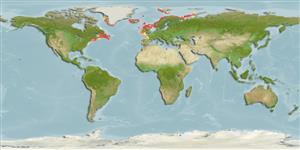Environment: milieu / climate zone / depth range / distribution range
Ecologia
marinhas demersal; intervalo de profundidade 94 - 113 m (Ref. 51665). Polar
Northeast Atlantic: southern Barents Sea to southern Scandinavia, Svalbard Archipelago, off Iceland and in the Denmark Strait.
Tamanho / Peso / Idade
Maturity: Lm ? range ? - ? cm
Max length : 28.0 cm TL macho/indeterminado; (Ref. )
Depth range from type locality data (Ref. 51665).
Life cycle and mating behavior
Maturities | Reprodução | Spawnings | Egg(s) | Fecundities | Larvas
Anderson, M.E. and V.V. Fedorov, 2004. Family Zoarcidae Swainson 1839. Eelpouts. Calif. Acad. Sci. Annotated Checklists of Fishes (34):58. (Ref. 51665)
Categoria na Lista Vermelha da IUCN (Ref. 130435)
Ameaça para o homem
Harmless
Utilização humana
Ferramentas
Relatórios especiais
Descarregue XML
Fontes da internet
Estimates based on models
Preferred temperature (Ref.
123201): 0.7 - 9.7, mean 5.4 °C (based on 54 cells).
Phylogenetic diversity index (Ref.
82804): PD
50 = 0.5000 [Uniqueness, from 0.5 = low to 2.0 = high].
Bayesian length-weight: a=0.00263 (0.00137 - 0.00504), b=3.22 (3.06 - 3.38), in cm total length, based on LWR estimates for this Genus-body shape (Ref.
93245).
Nível Trófico (Ref.
69278): 3.6 ±0.20 se; based on food items.
Generation time: 7.8 ( na - na) years. Estimated as median ln(3)/K based on 2
growth studies.
Resiliência (Ref.
120179): Médio, tempo mínimo de duplicação da população 1,4 - 4,4 anos (Tmax = 10; K= 0.14-0.39).
Fishing Vulnerability (Ref.
59153): Low vulnerability (18 of 100).
